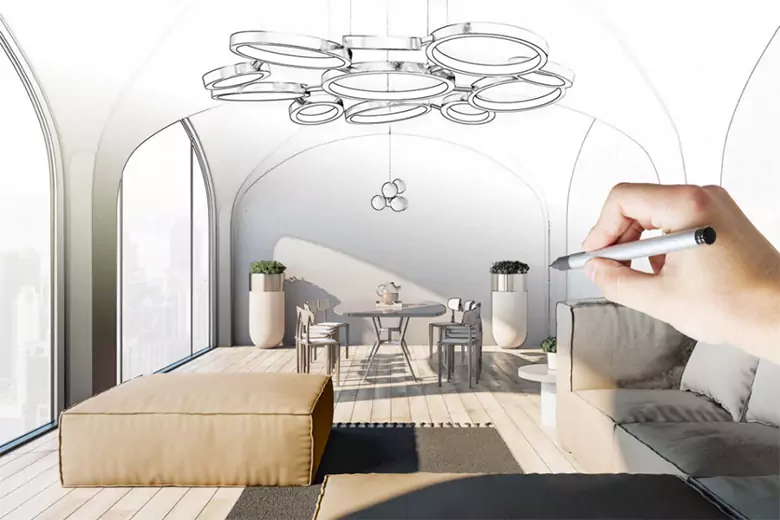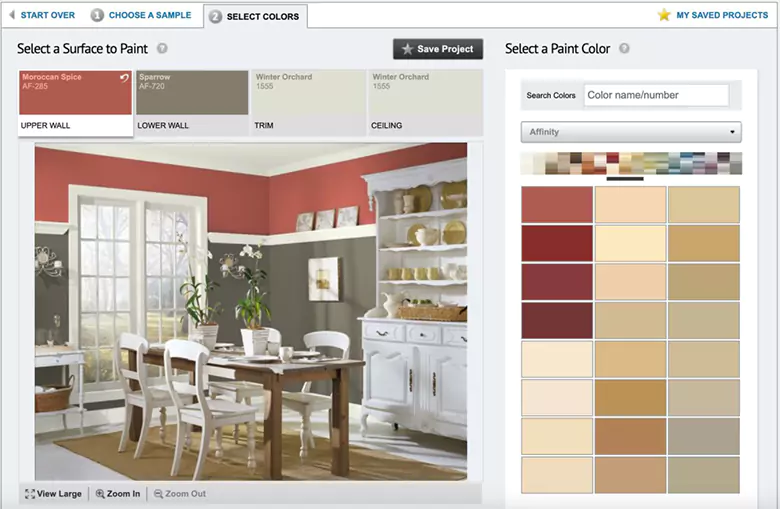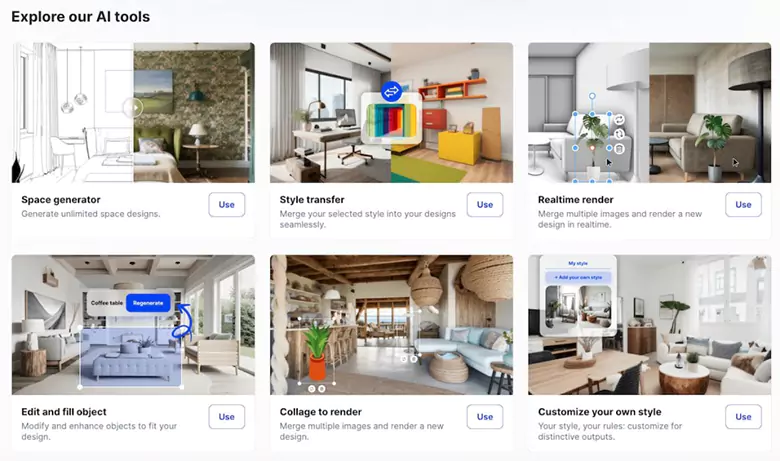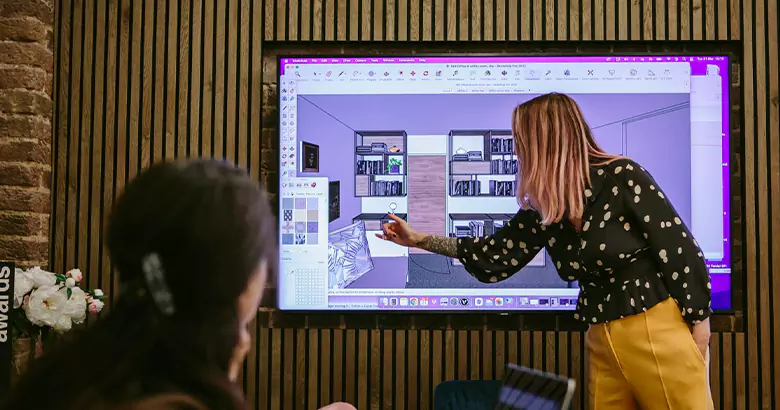Curious about using AI in your interior design projects? Understand its features, benefits, and applications in this comprehensive guide, along with some actionable tips.
It’s almost impossible to find an industry that hasn’t been disrupted by the emergence of artificial intelligence (AI). With advanced AI platforms evolving overnight, it’s no surprise that they have taken the interior design industry by storm, and resisting these tools no longer seems like a viable option.
As these tools become more accessible, they are gradually increasing the potential of interior designers to work more efficiently. Far from replacing designers, AI is here to empower them—streamlining workflows, improving productivity, and automating repetitive tasks. In this guide, we will walk you through the various aspects of AI in interior design and ensure you take back something valuable.
Here’s everything we’ll be covering in this article!
- Artificial intelligence and its relevance to interior design
- Features that broaden the potential of AI in interior design
- Benefits of using AI in Interior Design
- Practical applications of AI in interior design
- Essential tips for making the most of AI
- What does the future hold?
Artificial intelligence and its relevance to interior design
AI-powered tools allow designers to achieve a level of accuracy, efficiency, and freedom to think outside the box that was previously unattainable. It enhances various aspects of the design process, from generating realistic 3D visualizations and interactive virtual designs to recommending furniture layouts and color schemes based on client preferences. AI helps designers bridge the gap between conceptual ideas and tangible results, providing clients with a more personalized and highly customized experience.
Moreover, AI tools are not just about saving time—they’re about expanding possibilities. Whether you’re an established professional or an aspiring designer, understanding and learning the ropes of including AI in your workflow is essential to thrive in this ever-evolving field.

Image Courtesy: Interior Ideas
What broadens the potential of AI in interior design?
AI comes with advanced features designed to enhance efficiency and streamline workflows. They redefine how interiors are designed, experienced, presented, and managed as a service. Let’s look at what all AI offers in detail and understand each offering’s impact as well as the tools to use.
1. AI-powered interior design tools
AI-powered tools leverage machine learning algorithms to generate design ideas and layouts customized to specific inputs like room dimensions, style preferences, and budget. Tools such as Planner 5D, InteriorAI, and MidJourney enable designers to experiment with various furniture arrangements, paint colors, and finishes, offering multiple design concepts in a fraction of the time. This not only boosts efficiency but also reduces resource usage.
Popular AI design tools:
- Planner 5D: A highly intuitive platform for creating detailed interior designs, floor plans, and 3D visualizations. Ideal for both beginners and professionals, it simplifies the process of turning ideas into tangible designs.
- InteriorAI: An advanced AI-driven tool that generates personalized interior design recommendations based on user preferences. It makes achieving customized and client-specific results easier than ever.
- MidJourney: A creative AI tool that generates stunning visuals and conceptual designs from text prompts. Perfect for mood boards and exploring unique design ideas, it helps designers experiment and present visually engaging concepts.
- Homestyler: With over 10 million users, Homestyler is a trusted name in AI-powered interior design. Its features include a 3D floor planner, a virtual design studio, and collaboration tools, making it ideal for team projects. Designers can use it to generate detailed visualizations and share ideas seamlessly with clients and colleagues.
- Leaperr: It uses advanced machine-learning algorithms to create realistic renderings and interactive designs in minutes. Though still in development, this platform shows immense potential for revolutionizing how designers conceptualize and present their ideas.
Pro Tip: Start with free or trial versions of AI design tools to familiarize yourself with their features. This hands-on experience will help you choose the best tools for your needs and workflow.
2. Augmented Reality (AR) and Virtual Reality (VR) integration
AR and VR technologies have completely changed how designers and clients visualize spaces. AI-powered platforms equipped with AR and VR capabilities allow users to immerse themselves in a virtual version of a completed space, even during the initial design stages. Instead of relying solely on static renderings or floor plans, clients can walk through their future homes or offices, experiencing the layout, textures, and ambiance firsthand.
This interactive approach boosts client confidence and enables designers to make real-time adjustments, resulting in more accurate and satisfying outcomes.
Tools offering AR and VR capabilities
- SketchUp: A widely-used 3D modeling software that supports VR and AR visualizations. With devices like Meta Quest Pro and Microsoft HoloLens, designers can bring their 3D models to life in immersive ways.
- Foyr: A cloud-based design platform with VR and AR features, ideal for interactive and visually striking interior design presentations.
- Autodesk 3ds Max: A professional-grade 3D modeling and rendering tool that enables the creation of VR and AR visualizations for high-end, photorealistic design projects.
Pro Tip: Invest in compatible hardware and software to seamlessly integrate VR and AR into your design process. Experiment with these technologies to create immersive design concepts that captivate your clients and enhance your presentations.

3. Personalized recommendations based on user preferences
AI excels at personalization when it comes to interior design. Modern AI tools can analyze user preferences—whether it’s a love for minimalist aesthetics, bold colors, or contemporary furniture—and tailor design suggestions accordingly. This allows designers to create personalized and one-of-a-kind designs that resonate with their clients. This level of customization ensures that every design feels personal and aligned with the client’s vision, making the entire process more collaborative and enjoyable.
Tools for personalized design recommendations
- Canva: Although primarily a graphic design tool, Canva is excellent for creating personalized design mood boards, presentations, and visual content tailored to user preferences. It’s a great way to present cohesive and visually compelling design ideas to clients.
- DecorMatters: A mobile application that integrates AI and AR technology to deliver customized design suggestions. Users can visualize designs in their actual spaces, making it easier to experiment with furniture and decor choices.
Pro Tip: Integrate AI-powered recommendation tools into your workflow to better understand client preferences and create data-driven design proposals.
4. Predictive analysis for decision-making
One of the most exciting aspects of AI in design is its ability to forecast trends through predictive analysis. AI tools can identify emerging design trends before they become mainstream by analyzing data from social media, industry reports, and consumer behavior. This insight allows designers to experiment with newer ideas and offer innovative solutions that set them apart in the market.
Tools for predictive analytics
- WGSN: A renowned trend-forecasting platform offering data-driven insights across industries, including interior design. It provides valuable information on upcoming interior design styles, materials, and consumer behaviors.
- Google Trends: A free, user-friendly tool for monitoring design trends and tracking popular search terms related to interior design. Perfect for identifying what’s gaining traction in the industry.
- Chaos Scans: A comprehensive library of realistic material textures from Chaos Group. This tool helps designers stay updated on trending finishes and materials, adding a modern touch to their projects.
Pro Tip: Incorporate AI-driven analytics into your research process to track design trends and gather insights into what consumers are looking for, helping you craft designs that resonate with current and future demands.
5. Streamlined communication and project management
AI-powered tools are transforming how designers manage communication and projects. Chatbots like ChatGPT can handle routine tasks such as answering FAQs and scheduling appointments, allowing designers to focus on creative and strategic work. Meanwhile, AI-driven project management tools help keep track of deadlines, budgets, and key project details, ensuring smooth operations from start to finish.
Tools for streamlined communication and management
- ChatGPT: An AI chatbot developed by OpenAI that can be integrated into your website or messaging platforms to handle routine customer queries, schedule appointments, and provide instant support, creating a seamless client experience.
- Trello: A versatile project management tool that helps interior designers organize tasks, track deadlines, and manage budgets. Pair Trello with AI chatbots like ChatGPT to enhance its capabilities and streamline your project management processes.
Pro Tip: Explore AI chatbots like ChatGPT and consider integrating one into your website or communication channels. This will enhance client interactions and streamline workflows, improving overall efficiency.

Image Courtesy: LinkedIn
Benefits of Using AI in Interior Design
Now that we’ve explored the scope of AI in interior design, let’s move on to the benefits it brings to the table. While AI in interior design is still a relatively new concept, its benefits are already making a significant impact.
1. Enhanced efficiency and creativity
AI tools automate time-consuming tasks like creating renderings, generating design concepts, or optimizing furniture layouts, allowing designers to focus on the creative aspects of their work. These tasks, which previously required hours or even days, can now be completed in minutes. This efficiency doesn’t just help designers achieve quicker turnaround times and increased productivity but also allows clients to see results faster and confidently make informed decisions. Moreover, the vast range of design possibilities generated by AI encourages designers to take a plunge and explore ideas they might not have considered otherwise.
2. Optimized space planning
Space optimization is a critical aspect of interior design, and AI excels in this area. Tools that analyze floor plans can recommend furniture layouts and configurations to maximize functionality and aesthetic appeal. This is especially valuable for designing smaller or uniquely shaped spaces where every square foot matters.
3. Affordable design solutions
AI tools can help designers create budget-friendly solutions by analyzing material costs, suggesting alternatives, and optimizing resources. This ensures the project stays within budget and allows for high-quality designs without unnecessary expenses.
4. Sustainable designs
AI tools can recommend eco-friendly materials, energy-efficient designs, and best practices based on a project’s requirements. These recommendations help designers reduce environmental impact while meeting the growing demand for green design solutions.
5. Improved visualizations and conceptualization
AI tools with augmented reality (AR) and virtual reality (VR) capabilities allow designers to virtually step into the spaces they intend to design. This experience helps clients visualize the final outcome with greater clarity, making it easier to provide feedback and make decisions. These realistic visualizations also reduce the chances of miscommunication and ensure improved client experience.
6. Streamlined collaboration and communication
AI-powered project management tools and chatbots simplify communication and task management. Chatbots can handle routine client interactions, such as answering questions or scheduling appointments, while project management tools help track deadlines, budgets, and milestones. This streamlined communication reduces errors, improves organization, and ensures projects run smoothly.
7. Scalability for large-scale projects
AI’s ability to handle vast data makes it ideal for large-scale projects, such as commercial spaces or multi-unit developments. Designers can use AI tools to efficiently manage complex projects, ensuring consistency and quality across multiple spaces.
Practical applications of AI in Interior Design

Image Courtesy: The Spruce
Here are some practical applications that address everyday challenges faced by interior designers.
1. Smart furniture placement
Arranging furniture to maximize space and functionality can be daunting, especially in small or awkwardly shaped rooms. AI tools simplify this process by analyzing floor plans and suggesting optimal furniture layouts. These tools consider factors like traffic flow, room dimensions, and even ergonomic principles to create designs that are aesthetically pleasing and highly functional.
2. Selecting color palettes
By analyzing room size, lighting, furniture, and client preferences, AI can suggest appropriate color palettes that enhance the overall ambiance of a space. These recommendations not only save time but also encourage designers to explore unique combinations.
3. Advanced lighting solutions
Lighting in interior design influences mood, functionality, and visual appeal. AI-powered platforms now offer advanced lighting simulations, allowing designers to experiment with different lighting types and placements. From ambient and task lighting to accent lighting, these tools help designers envisage the perfect balance, ensuring every corner of the room is well-lit and visually striking.
Essential tips for making the most of AI in Interior Design
Feeling unsure about integrating AI in interior design? Here are some simple yet effective tips that can help you get started:
1. Have an open mind
AI is meant to enhance your work, not replace your skills. Approach AI technologies with a willingness to learn and experiment. Recognize that while there may be a learning curve, the benefits of adopting AI range from simplifying your process to even improving your work by taking over mundane tasks and opening up mental bandwidth.
2. Recognize and pick the right tools
Not all AI tools are the same, so identify your goals before investing in one. Whether you need help with ideation, space optimization, or creating realistic visualizations, select tools that align with your requirements. Explore trial versions to familiarize yourself with their features and determine which ones work best for your workflow.
3. Invest in learning
Dedicate time to understanding how AI tools function. Many platforms offer tutorials, guides, and support to help you get started. The more proficient you become, the more effortlessly you’ll be able to integrate these tools into your projects.
4. Incorporate AI into your current workflow
Use AI in your workflow as a tool to enhance, not replace, your existing processes. Combine AI-generated designs with your vision to ensure each project retains a distinctive, human-centered approach that reflects your personal style and expertise.

Image Courtesy: Decorilla
5. Focus on client collaboration
Leverage AI’s interactive features, such as AR/VR visualizations, to enhance client collaboration. These tools allow clients to understand your ideas better and provide meaningful feedback, creating a more engaging and efficient design process.
6. Balance automation and creativity
While AI can automate repetitive tasks, it’s best not to rely on it for design. Use AI to streamline and simplify your workflow, but let your expertise and intuition guide you in crafting personalized solutions that truly resonate with your clients.
7. Stay updated on AI trends
The field of AI is constantly evolving, with new tools and features being introduced regularly. Stay informed about emerging trends, innovations, and best practices.
8. Try collaboration tools
Many AI-powered platforms integrate with project management tools, making coordinating with clients and team members easier. Explore options that enable seamless collaboration, helping you stay more organized and efficient.
9. Keep an eye on the results
Evaluate how AI is impacting your projects and workflow. Regularly assess the effectiveness of the tools you’re using and adapt as needed to optimize your processes.
Future of AI in Interior Design
As AI becomes essential to interior design, its impact will only grow. Knowing how to use AI tools will soon be an important know-how for interior designers, regardless of their experience level. Many interior design programs are now incorporating AI into their curriculums to meet this demand. This ensures that graduates enter the workforce with the skills and mindset required to tackle the tech-driven job market.
Whether you’re an industry expert or an aspiring interior designer, now is the best time to explore AI’s potential. You can check out this project by AND Learner, Ayushka Jain for your portfolio inspiration.
Next Steps
For more insights into the latest trends and apps for the interior design industry, please head over to the AND Academy Blog.
In case you need further assistance, here are some resources to consider:
- Watch this session by Snehanshu Mukherjee, Founding Partner at T.E.A.M and Mansi Almadi, an Interior Designer at Studio Lotus
- Talk to a course advisor to discuss how you can transform your career with one of our courses.
- Check out our Interior Design courses – all courses are taught through live, interactive classes by industry experts.
- Take advantage of our scholarship and funding options to overcome any financial hurdle on the path of your career transformation.
Note: All information and/or data from external sources is believed to be accurate as of the date of publication.









